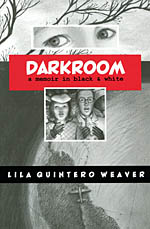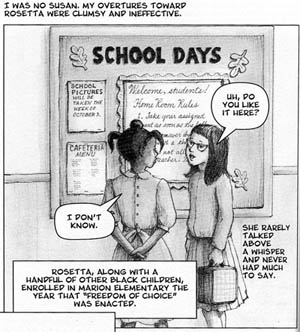 By Lila Quintero Weaver
By Lila Quintero Weaver
264 pages, black and white
Published by University of Alabama Press
I’ll be the first to admit that I was a little surprised when I heard that the University of Alabama Press published a graphic novel. It’s not the usual suspect for this sort of thing, but within a handful of pages of Lila Quintero Weaver’s Darkroom: A Memoir of Black & White, it was easy to see why they’d stepped up to the plate. Latina in 1960s Alabama where everything was viewed as either black or white, Weaver’s memoir offers a perspective from someone unclaimed by either side in a racial struggle.
Darkroom quickly establishes the early life of Weaver and her family; having moved at the age of five from Buenos Aires, Argentina to Marion, Alabama where her father taught at two local colleges. Those early chapters of Darkroom might surprise those not from that part of the country; with the Latino population for the country as a whole on the rise, the idea of the Quintero family being the only representatives of that group can feel a bit odd. It puts Weaver and the rest of her family in a unique position, though, because they don’t quite fit in with either of the two halves of Marion. Weaver does a good job in expressing her younger self Lila’s befuddlement growing up; allowed to attend the segregated white schools, she doesn’t quite fit in while also not being exiled to the establishments set up for African-Americans. "I saw that each side afforded the other a distinct interpretation of respect," she notes, the outsider watching the situation unfold around her. And as Lila learns the rules of what she can and can’t do, it in many ways comes across with a strong tinge of sadness; Lila is losing her some small pieces of her innocence. At the same time, though, she and the rest of her family are still never quite accepted by the white population, and Weaver conveys without stating outright that it helps with her ever becoming fully complacent; she knows that they don’t quite fit in, and as a result it becomes much easier to question the white rule.
 It almost goes without saying that the marches in places like Marion and Selma are important parts of Darkroom, events that ultimately shook the nation and were directly responsible for the Voting Rights Act of 1965. Weaver gives her memories of them, ones that helped in part because her father (an amateur photographer) had gone to see the march in Marion for himself. Weaver’s depiction of what happened there is well crafted, with the panels growing darker as the lights are turned off and the panels starting to shift and tilt in a chaotic fashion when violence breaks out. Weaver’s normal detail grows hazier as the confusion grows that evening, and it’s a great example of how story and art each tell their own part of the story in a comic.
It almost goes without saying that the marches in places like Marion and Selma are important parts of Darkroom, events that ultimately shook the nation and were directly responsible for the Voting Rights Act of 1965. Weaver gives her memories of them, ones that helped in part because her father (an amateur photographer) had gone to see the march in Marion for himself. Weaver’s depiction of what happened there is well crafted, with the panels growing darker as the lights are turned off and the panels starting to shift and tilt in a chaotic fashion when violence breaks out. Weaver’s normal detail grows hazier as the confusion grows that evening, and it’s a great example of how story and art each tell their own part of the story in a comic.
At the same time, though, it’s a testament to Darkroom that the marches themselves are only one small chapter in the greater whole of the book, and that Weaver keeps the story moving at a strong pace before and after. I found myself caring deeply about her and her family, and I appreciated that she didn’t feel the need to make herself the center of every incident. Relating how she wasn’t always the one to come to the rescue of the newly integrated students helps keep the story grounded and realistic, and when Lila herself is reminded that she still isn’t part of either side in the conflict it’s a bit of a jolt. Weaver has a strong storytelling voice, one that keeps the reader locked in and holding their attention.
 Weaver’s art is beautiful, a series of delicately shaded pencil drawings that show a strong understanding of how to render portraits. As Lila grows, Weaver’s depictions of herself adjust accordingly; the button eyes and nose grow more nuanced, the expressions less cheerful and naive. Crowd scenes are especially impressive, with dozens of faces that each look distinct and different. While it’s easy to compare Darkroom to similarly themed books like Howard Cruse’s Stuck Rubber Baby, the main connection between the two for me is how well Weaver, like Cruse, is able to make every person she draws a unique individual.
Weaver’s art is beautiful, a series of delicately shaded pencil drawings that show a strong understanding of how to render portraits. As Lila grows, Weaver’s depictions of herself adjust accordingly; the button eyes and nose grow more nuanced, the expressions less cheerful and naive. Crowd scenes are especially impressive, with dozens of faces that each look distinct and different. While it’s easy to compare Darkroom to similarly themed books like Howard Cruse’s Stuck Rubber Baby, the main connection between the two for me is how well Weaver, like Cruse, is able to make every person she draws a unique individual.
Darkroom: A Memoir in Black & White is a strong debut for Weaver, and a book well worth your time. It’s to Weaver’s credit that when the book came to a close, my first thought was that I wanted to continue to read about the Quintero family and what happened next in their lives. The subject material might be hard to take at times, but the delivery is warm and welcoming. She’s able to mix the perilous with the humorous (the excerpts from the Know Alabama textbook are simultaneously jaw-dropping and hysterical as you see just what students were taught in that time period), and the end result is fantastic. If Weaver creates another graphic novel, I know I’ll be quick to buy it. Well done.
Purchase Links: Amazon.com | Powell’s Books

@gregmce @UnivofALPress Thank you, Greg! Super nice review!
RT @gregmce: REVIEW: Darkroom: A Memoir in Black & White: http://t.co/XR0BOOkmx2 @LilaQWeaver @UnivofALPress
.@gregmce on ‘Darkroom,’ a graphic memoir that tells the story of a Latino family living in 1960s Alabama http://t.co/SNIzQjHDuf #comics
RT @gregmce: REVIEW: Darkroom: A Memoir in Black & White: http://t.co/XR0BOOkmx2 @LilaQWeaver @UnivofALPress
Lila Weaver is a wonderful artist and storyteller! I dearly loved her book and hope she will write many, many more. So talented!